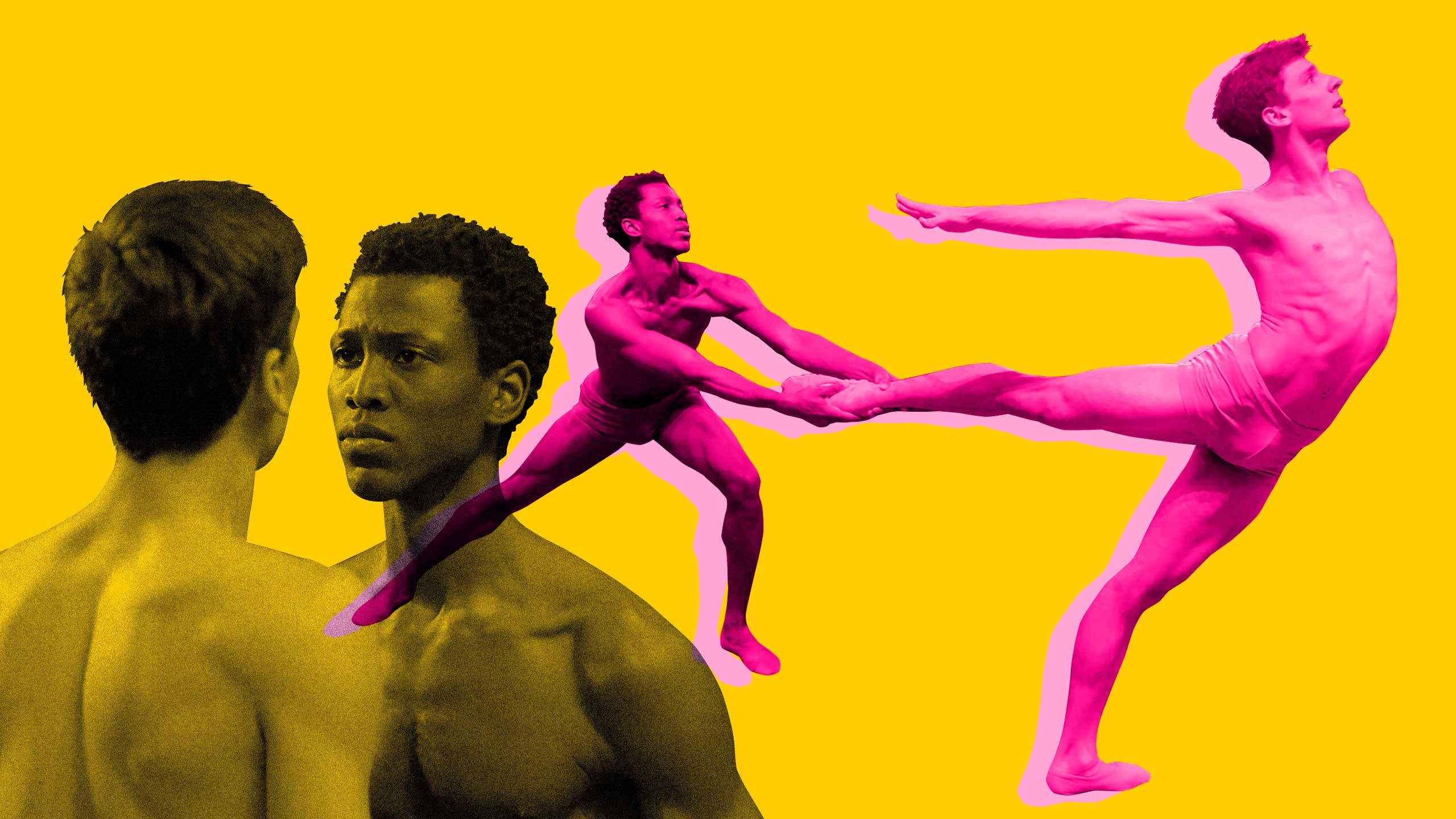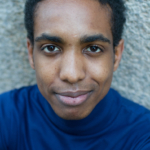I remember it like it was yesterday.
In an erotically charged scene that could easily be the start of either a porno or a brutal fight, two men—one Black, one white—stand centre stage, breathing heavily and baring their naked chests to each other. As the lovers come together in a gentle embrace, one man pulls the other across the floor, like the sail of a ship breezing in the wind. They alternate between lovingly supporting and suspending each other with the reciprocal spirit of Fred Astaire and Ginger Rogers, each giving as much as they receive. When their legs aren’t flying towards the ceiling, they cradle one another in heartstopping lifts that put Jennifer Grey’s Dirty Dancing swan dive lift to shame.
At one point, the white man jumps onto his partner’s shoulders crotch first, holding onto his partner’s face between his legs. It is shocking, and suggestive. Falling backwards, the Black man is caught, saved by his lover’s legs. They roll onto the floor, ending with a kiss.
This scene from choreographer Christopher Rudd’s ballet Touché, which premiered in November during American Ballet Theatre’s (ABT) online 80th anniversary celebration, reduced me to tears. After 20 years as a dancer—and now as a writer who covers the industry—I had never seen two men kiss in ballet.
It turns out that I’m not alone: Rudd’s creation is the first romantic same-sex pas de deux in ABT’s history, and one of the first—if not the first—to celebrate queer lust so explicitly in ballet. Such a feat, while to be applauded, is long overdue for a world in which more than half of the men who perform in and champion the artform are members of the LGBTQ2S+ community, according to Dance Magazine. Maybe times are finally changing.
“There are so many gay people who have never seen themselves represented on a ballet stage and I knew that I had to be part of changing that,” Rudd says.
Ballet was born in the Italian Renaissance courts of the 15th century. A century later, King Louis XIV—a dancer himself—helped popularize and standardize the artform. Though styles have since changed, the story remains mostly the same: Can the guy bag the gal or not? To this day, male and female dancers are instructed to move in wholly different ways. Such a binary obsession with preserving patriarchal traditions is the driving force behind the most popular ballets in the world, from Swan Lake to Sleeping Beauty, Giselle and Raymonda. And even though gay (white) men have been central to ballet over the last 100 years, audiences are still being pummeled with visions of straight sex, as if no alternative exists.
Of course, there have been silent allusions to homosexuality in classical ballet in the past. According to Paul Boos, a répétiteur for the Balanchine Trust which oversees the ballets of George Balachine all over the world, there is a section between two same-sex couples in Jerome Robbins’ Goldberg Variations, which insiders have always understood to be about queer love. But Boos cautions that this interpretation is in the eyes of the beholder. “You see what you want to see,” he says. “It’s neither overt nor romantic.”
Other prominent instances of same-sex partnering include Lar Lubovitch’s testament to friendship, Concerto Six Twenty-Two, which he created in response to the AIDS epidemic; and Wayne McGregor’s exploration of Virginia Woolf’s life, Woolf Works, which features a tortured duet between a war veteran and the ghost of his dead lover. Strangely enough there are more overt examples of heterosexual pedophilia in ballet—including Kenneth Macmillan’s The Invitation and Flemming Flindt’s The Lesson—than there are of queer romance.
That’s what makes Touché (meaning “touched” in French) essential. Without apologizing for or pathologizing our existence, it balances the fear of being outed with the joy of feeling safe enough to embrace one’s desires. And while one can interpret the central couple’s erotic grapplings and loving embraces in myriad ways, their kiss eradicates any doubt that the ballet is a celebration of queer love.
Rudd, a Black gay man born in Jamaica, says that he created the piece—which features dancers Calvin Royal III and João Menegussi—to help normalize queer love and lust in ballet. He said he wanted to show “how brave it is to accept oneself in a world where for so long we have been denied our existence or the right to see anyone that looks like us.”
Rudd was inspired to create Touché after nearly dying from a COVID-19 infection last summer. “I didn’t think I was going to make it”, he says, “and I really had to come to terms with my own mortality and whether or not the fight was worth it anymore; and if I was going to keep fighting, what was I fighting for?”
Following his recovery, he says he realized that something in his art had to change. Rudd then contacted Kevin McKenzie, American Ballet Theatre’s artistic director, and told him that the dance he’d been choreographing had to be a gay love duet between two men. McKenzie supported the decision, and provided the resources necessary to make it happen.
Prior to his near-death experience, Rudd says that he might not have taken that risk. But his “come-to-Jesus moment” pushed him to use the exposure of choreographing for ABT, considered “America’s National ballet company,” to remind the ballet world that queer love matters.
The response has been overwhelmingly positive, but it marks just the beginning of classical ballet’s necessary coming out story. Harper Watters, a soloist with Houston Ballet who has been celebrated for his uplifting and gender-subverting videos in heels across social media, sees Touché as part of an essential movement to break ballet’s traditions of toxic patriarchy. He says that we need to increase “queer visibility and diversity in ballet’s storytelling and lean into the feelings that we have outside of the studio.”
Though ballet has long been considered a safe haven for queer-identifying men, it is also driven by binary portrayals wherein male dancers are expected to “butch it up.” Watters says that this “lazy” critique infuriates him. “I don’t have to grab a boob to be me in ballet,” he says. “And if I’m not being me, then what am I doing?” Indeed, audiences want dancers to reveal themselves, not hide.
For Leroy Mokgatle, a South African dancer with Béjart Ballet in Switzerland, embracing his true self saved his life. When the phenomenal dancer burst onto the international dance scene at the 2016 Prix de Lausanne—a prestigious dance competition where he won the coveted Audience Favourite prize—it seemed that his future as a dance star was confirmed. But soon afterwards, Mokgatle began to appear in pointe shoes, which caused many to question his viability.
In ballet, a man in pointe shoes is a signal to the audience that everything they are about to see is a joke, much like Milton Berle in drag. Though Mokgatle could have had a career with Les Ballets Trockadero de Monte Carlo (a ballet comedy troupe that features men in drag and pointe shoes), he held onto his desire to be taken seriously despite the discrimination he faced.
“It’s taken quite a lot from me,” he says. “I was always that boy that was very delicate; my body was not able to do those very ‘manly’ things like double tours [double spins in the air].” Mokgatle says that he nearly quit until putting on pointe shoes which “brought that obsessive joy for dance back.”
As someone who continually rejects the idea of living in a gym or taking growth hormones to fit the image of a classical male dancer, he applauds what Rudd did— “especially with such an important company like ABT,” Mokgatle says. “Hopefully the rest of the world will wake up to see that we are more than just man and woman when it comes to love.”
Maxfield Haynes, a non-binary soloist with Complexions Ballet in New York, rejected performing with a classical ballet company because they didn’t want to live inside ballet’s square gender box. They agree with Mokgatle: Knowing that Touché exists gives them hope for the next generation. “Seeing that kiss was everything for me,” Haynes says. “I think about all of the gay boys out there. It’s like, ‘Finally! We exist.’ The fight isn’t over, but it’s a start.”
This story is published with support from the Ken Popert Media Fellowship program.


 Why you can trust Xtra
Why you can trust Xtra


